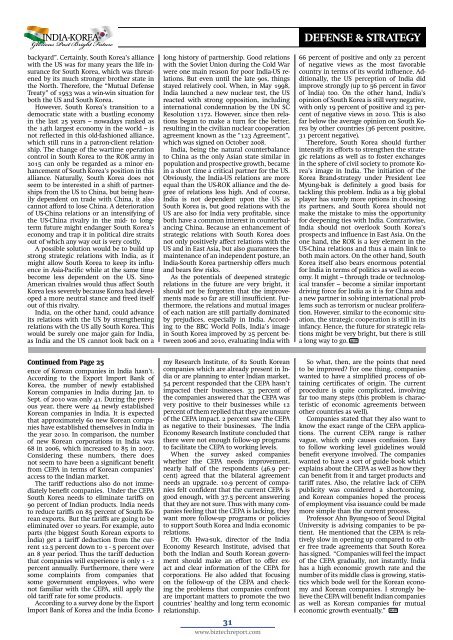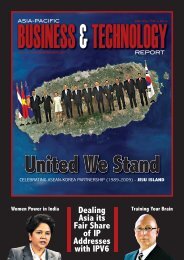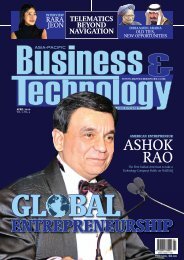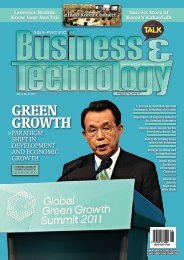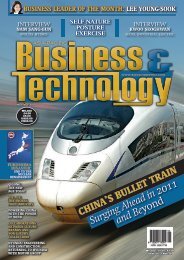INDIA-KOREA - Asia-Pacific Business and Technology Report
INDIA-KOREA - Asia-Pacific Business and Technology Report
INDIA-KOREA - Asia-Pacific Business and Technology Report
You also want an ePaper? Increase the reach of your titles
YUMPU automatically turns print PDFs into web optimized ePapers that Google loves.
<strong>INDIA</strong>-<strong>KOREA</strong><br />
Glorious Past Bright Future<br />
backyard”. Certainly, South Korea’s alliance<br />
with the US was for many years the life insurance<br />
for South Korea, which was threatened<br />
by its much stronger brother state in<br />
the North. Therefore, the “Mutual Defense<br />
Treaty” of 1953 was a win-win situation for<br />
both the US <strong>and</strong> South Korea.<br />
However, South Korea’s transition to a<br />
democratic state with a bustling economy<br />
in the last 25 years – nowadays ranked as<br />
the 14th largest economy in the world – is<br />
not reflected in this old-fashioned alliance,<br />
which still runs in a patron-client relationship.<br />
The change of the wartime operation<br />
control in South Korea to the ROK army in<br />
2015 can only be regarded as a minor enhancement<br />
of South Korea’s position in this<br />
alliance. Naturally, South Korea does not<br />
seem to be interested in a shift of partnerships<br />
from the US to China, but being heavily<br />
dependent on trade with China, it also<br />
cannot afford to lose China. A deterioration<br />
of US-China relations or an intensifying of<br />
the US-China rivalry in the mid- to longterm<br />
future might endanger South Korea’s<br />
economy <strong>and</strong> trap it in political dire straits<br />
out of which any way out is very costly.<br />
A possible solution would be to build up<br />
strong strategic relations with India, as it<br />
might allow South Korea to keep its influence<br />
in <strong>Asia</strong>-<strong>Pacific</strong> while at the same time<br />
become less dependent on the US. Sino-<br />
American rivalries would thus affect South<br />
Korea less severely because Korea had developed<br />
a more neutral stance <strong>and</strong> freed itself<br />
out of this rivalry.<br />
India, on the other h<strong>and</strong>, could advance<br />
its relations with the US by strengthening<br />
relations with the US ally South Korea. This<br />
would be surely one major gain for India,<br />
as India <strong>and</strong> the US cannot look back on a<br />
long history of partnership. Good relations<br />
with the Soviet Union during the Cold War<br />
were one main reason for poor India-US relations.<br />
But even until the late 90s, things<br />
stayed relatively cool. When, in May 1998,<br />
India launched a new nuclear test, the US<br />
reacted with strong opposition, including<br />
international condemnation by the UN SC<br />
Resolution 1172. However, since then relations<br />
began to make a turn for the better,<br />
resulting in the civilian nuclear cooperation<br />
agreement known as the “123 Agreement”,<br />
which was signed on October 2008.<br />
India, being the natural counterbalance<br />
to China as the only <strong>Asia</strong>n state similar in<br />
population <strong>and</strong> prospective growth, became<br />
in a short time a critical partner for the US.<br />
Obviously, the India-US relations are more<br />
equal than the US-ROK alliance <strong>and</strong> the degree<br />
of relations less high. And of course,<br />
India is not dependent upon the US as<br />
South Korea is, but good relations with the<br />
US are also for India very profitable, since<br />
both have a common interest in counterbalancing<br />
China. Because an enhancement of<br />
strategic relations with South Korea does<br />
not only positively affect relations with the<br />
US <strong>and</strong> in East <strong>Asia</strong>, but also guarantees the<br />
maintenance of an independent posture, an<br />
India-South Korea partnership offers much<br />
<strong>and</strong> bears few risks.<br />
As the potentials of deepened strategic<br />
relations in the future are very bright, it<br />
should not be forgotten that the improvements<br />
made so far are still insufficient. Furthermore,<br />
the relations <strong>and</strong> mutual images<br />
of each nation are still partially dominated<br />
by prejudices, especially in India. According<br />
to the BBC World Polls, India’s image<br />
in South Korea improved by 25 percent between<br />
2006 <strong>and</strong> 2010, evaluating India with<br />
Defense & STRATEGY<br />
66 percent of positive <strong>and</strong> only 22 percent<br />
of negative views as the most favorable<br />
country in terms of its world influence. Additionally,<br />
the US perception of India did<br />
improve strongly (up to 56 percent in favor<br />
of India) too. On the other h<strong>and</strong>, India’s<br />
opinion of South Korea is still very negative,<br />
with only 19 percent of positive <strong>and</strong> 23 percent<br />
of negative views in 2010. This is also<br />
far below the average opinion on South Korea<br />
by other countries (36 percent positive,<br />
31 percent negative).<br />
Therefore, South Korea should further<br />
intensify its efforts to strengthen the strategic<br />
relations as well as to foster exchanges<br />
in the sphere of civil society to promote Korea’s<br />
image in India. The initiation of the<br />
Korea Br<strong>and</strong>-strategy under President Lee<br />
Myung-bak is definitely a good basis for<br />
tackling this problem. India as a big global<br />
player has surely more options in choosing<br />
its partners, <strong>and</strong> South Korea should not<br />
make the mistake to miss the opportunity<br />
for deepening ties with India. Contrariwise,<br />
India should not overlook South Korea’s<br />
prospects <strong>and</strong> influence in East <strong>Asia</strong>. On the<br />
one h<strong>and</strong>, the ROK is a key element in the<br />
US-China relations <strong>and</strong> thus a main link to<br />
both main actors. On the other h<strong>and</strong>, South<br />
Korea itself also bears enormous potential<br />
for India in terms of politics as well as economy.<br />
It might – through trade or technological<br />
transfer – become a similar important<br />
driving force for India as it is for China <strong>and</strong><br />
a new partner in solving international problems<br />
such as terrorism or nuclear proliferation.<br />
However, similar to the economic situation,<br />
the strategic cooperation is still in its<br />
infancy. Hence, the future for strategic relations<br />
might be very bright, but there is still<br />
a long way to go. A-P<br />
Continued from Page 25<br />
ence of Korean companies in India hasn’t.<br />
According to the Export Import Bank of<br />
Korea, the number of newly established<br />
Korean companies in India during Jan. to<br />
Sept. of 2010 was only 41. During the previous<br />
year, there were 44 newly established<br />
Korean companies in India. It is expected<br />
that approximately 60 new Korean companies<br />
have established themselves in India in<br />
the year 2010. In comparison, the number<br />
of new Korean corporations in India was<br />
68 in 2006, which increased to 85 in 2007.<br />
Considering these numbers, there does<br />
not seem to have been a significant benefit<br />
from CEPA in terms of Korean companies’<br />
access to the Indian market.<br />
The tariff reductions also do not immediately<br />
benefit companies. Under the CEPA<br />
South Korea needs to eliminate tariffs on<br />
90 percent of Indian products. India needs<br />
to reduce tariffs on 85 percent of South Korean<br />
exports. But the tariffs are going to be<br />
eliminated over 10 years. For example, auto<br />
parts (the biggest South Korean exports to<br />
India) get a tariff deduction from the current<br />
12.5 percent down to 1 - 5 percent over<br />
an 8 year period. Thus the tariff deduction<br />
that companies will experience is only 1 - 2<br />
percent annually. Furthermore, there were<br />
some complaints from companies that<br />
some government employees, who were<br />
not familiar with the CEPA, still apply the<br />
old tariff rate for some products.<br />
According to a survey done by the Export<br />
Import Bank of Korea <strong>and</strong> the India Economy<br />
Research Institute, of 82 South Korean<br />
companies which are already present in India<br />
or are planning to enter Indian market,<br />
54 percent responded that the CEPA hasn’t<br />
impacted their businesses. 33 percent of<br />
the companies answered that the CEPA was<br />
very positive to their businesses while 12<br />
percent of them replied that they are unsure<br />
of the CEPA impact. 2 percent saw the CEPA<br />
as negative to their businesses. The India<br />
Economy Research Institute concluded that<br />
there were not enough follow-up programs<br />
to facilitate the CEPA to working levels.<br />
When the survey asked companies<br />
whether the CEPA needs improvement,<br />
nearly half of the respondents (46.9 percent)<br />
agreed that the bilateral agreement<br />
needs an upgrade. 10.9 percent of companies<br />
felt confident that the current CEPA is<br />
good enough, with 37.5 percent answering<br />
that they are not sure. Thus with many companies<br />
feeling that the CEPA is lacking, they<br />
want more follow-up programs or policies<br />
to support South Korea <strong>and</strong> India economic<br />
relations.<br />
Dr. Oh Hwa-suk, director of the India<br />
Economy Research Institute, advised that<br />
both the Indian <strong>and</strong> South Korean government<br />
should make an effort to offer exact<br />
<strong>and</strong> clear information of the CEPA for<br />
corporations. He also added that focusing<br />
on the follow-up of the CEPA <strong>and</strong> checking<br />
the problems that companies confront<br />
are important matters to promote the two<br />
countries’ healthy <strong>and</strong> long term economic<br />
relationship.<br />
31<br />
www.biztechreport.com<br />
So what, then, are the points that need<br />
to be improved? For one thing, companies<br />
wanted to have a simplified process of obtaining<br />
certificates of origin. The current<br />
procedure is quite complicated, involving<br />
far too many steps (this problem is characteristic<br />
of economic agreements between<br />
other countries as well).<br />
Companies stated that they also want to<br />
know the exact range of the CEPA applications.<br />
The current CEPA range is rather<br />
vague, which only causes confusion. Easy<br />
to follow working level guidelines would<br />
benefit everyone involved. The companies<br />
wanted to have a sort of guide book which<br />
explains about the CEPA as well as how they<br />
can benefit from it <strong>and</strong> target products <strong>and</strong><br />
tariff rates. Also, the relative lack of CEPA<br />
publicity was considered a shortcoming,<br />
<strong>and</strong> Korean companies hoped the process<br />
of employment visa issuance could be made<br />
more simple than the current process.<br />
Professor Ahn Byung-soo of Seoul Digital<br />
University is advising companies to be patient.<br />
He mentioned that the CEPA is relatively<br />
slow in opening up compared to other<br />
free trade agreements that South Korea<br />
has signed. “Companies will feel the impact<br />
of the CEPA gradually, not instantly. India<br />
has a high economic growth rate <strong>and</strong> the<br />
number of its middle class is growing, statistics<br />
which bode well for the Korean economy<br />
<strong>and</strong> Korean companies. I strongly believe<br />
the CEPA will benefit Indian companies<br />
as well as Korean companies for mutual<br />
economic growth eventually.” A-P


